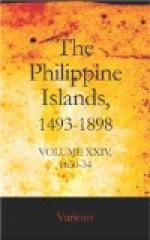CHAPTER XLIII
Continuation of the preceding
The trade and commerce of the Japanese Islands has always been considered of great importance in these islands; for, as the former are rich in metals and foods, what is needed here can be brought thence at moderate prices. Formerly the Manila traders made much more profit by sending their goods to Japon than to Espana, for they saw the returns from them more quickly and at less risk. The governors have sought this trade very earnestly. Don Alfonso Fajardo sent two ambassadors, namely, Don Juan de Arceo and Don Fernando de Ayala, who were very influential men of Manila; they carried a goodly present with them. But that barbarian refused to admit them, whereupon they returned abashed, without effecting anything. All this rancor has arisen through his expulsion of the orders [from Japan], and his prohibition against preaching any new religion in his country. Although the emperors have done this in their zeal for their idolatries, the credence given to a falsehood told them by the Dutch has aided greatly in it. The Dutch told the emperor, in short, that he should beware of the European religious, for that by their means the king of Castilla made himself sovereign of foreign kingdoms; for after they had entered the country and reduced it to their religion, the rest was easy. It is not necessary to prove the falsity of this, so apparent is it. Disguised religious have not on that account discontinued going to Japon, but continue that work, although the severity of the persecution is ever increasing.
In the year 30, the governor sent out two large galleons, with five hundred soldiers, besides the sailors; they were ordered to capture and bring to Manila any Dutch vessel found on the coasts of Siam and Camboja. Don Juan de Alcarazo was commander of the galleons, and Don Pedro de Mendiola was admiral. They sailed the seas at signal risk, as they were not extra large ships, and the city was very anxious. For should those galleons be lost, then was lost the strength of the islands. But, finally, the Lord brought them safely home, which was not a little fortunate. In the course of their wanderings they seized two ships or junks, one belonging to Siamese, the other to Japanese. They sent the Siamese vessel to Manila, but sacked and even burned the Japanese vessel. It is said they found great riches on it. Who could know the truth? This was learned in Japon, whereupon the hate and ill-will of that people toward us redoubled. They tried to collect the value of the junk from the Portuguese, who trade with Japon. They said that, since the Castilians and Portuguese had the same king, it made no difference which one of them paid. They seized the goods of the Portuguese from them, and then the latter found their business quickly despatched. They sent their ambassadors to Manila, and a most dignified father of the Society




